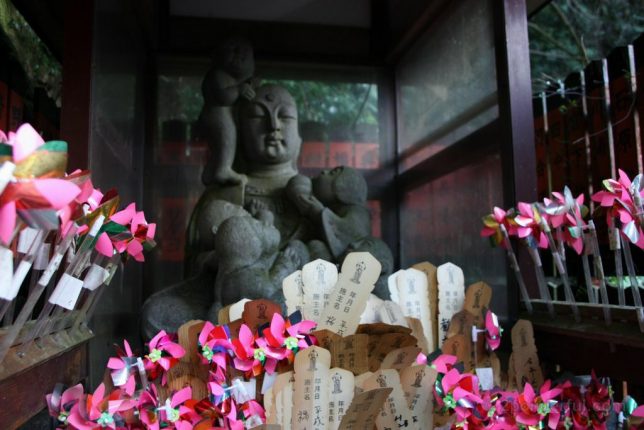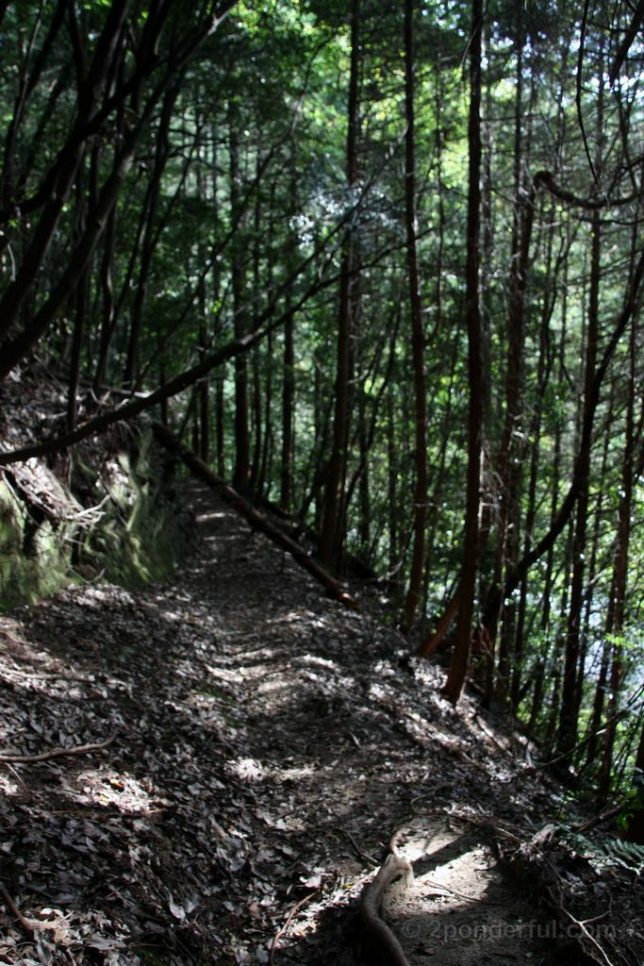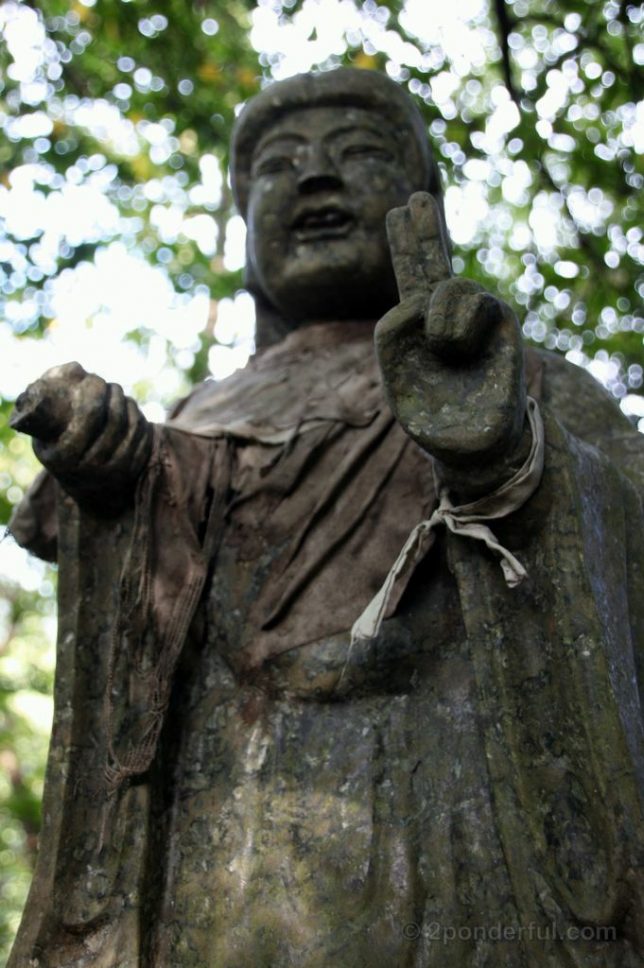“Fun” wouldn’t normally be the first adjective to describe a temple visit, but it fits the time to be had at Tanukidani Fudoin. It is certainly be a temple that kids would enjoy: there are hundreds of tanuki statues, there are 250 steps to be counted, and there are tanuki to help you to keep count of the steps! There is a torii gate tunnel to walk through, metal rings on staffs to shake, a mini Shikoku 88 pilgrimage circuit, some spooky glow-in-the-dark eyes and a trail to the top of the mountain that needs a chain!
Tanuki means “Japanese raccoon dog”. No? Me, neither. What on earth is a raccoon dog? Native to Japan, North and South Korea, parts of eastern China, Vietnam and east Russia, its English name isn’t really that enlightening. Every time I hear someone use the phrase “Japanese raccoon dog”, it reminds of a Japanese friend who insists on calling matcha the English mouthful “Japanese powdered green tea”. Despite me calling it matcha. Despite Starbucks selling matcha lattes all around the globe. So, tanuki, and not Japanese raccoon dog, it is. The temple’s name is already a mouthful!


Tanuki play an important role in Japanese folklore: it is considered something of a shape-shifter that likes causing trouble with its disguises. However, the animal has eight traits that apparently bring good luck or fortune: a welcoming smile; a hat to protect against the weather; big eyes and therefore good vision; a tail to provide steadiness and strength; large testicles that symbolise financial luck; a big belly to represent decisiveness; a sake bottle representing virtue and a promissory note suggesting trust.
The temple is situated about 400 metres east of Shisendo. It’s a bit of a climb. You walk past the large shrine dedicated to cars – yes, really, but not so strange if you are also someone who believes that a tanuki’s testicles bring fiscal fortune, I suppose. Then you follow the pillars engraved with the names of those who have donated funds, until you come across a… I wonder what the collective noun for tanuki is? It’s a pack of dogs but a gaze of raccoons. Let’s just go with a welcoming, a welcoming of tanuki greeting your arrival. After the obligatory selfie and spotting the tanuki who most resembles your uncle Terry, your boss, Bruce Willis, walk under the torii gate tunnel and spot the first helpful tanuki telling you that you have 250 steps yet to climb!

Half way up the first flight of stairs you will suddenly be confronted with a statue of the founder of the Shingon school of Buddhism Kobo Daishi. He completed the 1,200 kilometres of the 88 temple route on the Shikoku pilgrimage on foot, hence the hiking staffs found throughout the temple. You may be familiar with ringing a bell at a shrine, but here you should shake all the staffs with metal rings that you spot.
Before the final flight of stairs – you may well be cursing the tanuki markers by now – a sign in Japanese invites you to complete the Shikoku 88 temple circuit “the easy way”. I must admit, it was rather easy, taking approximately two minutes instead of the usual six weeks. Each paving stone sports the name of one of the temples: you step from stone to stone and “da da” you are a pilgrim, albeit of the most tenuous kind.
Many places in Japan are known as a diminutive version of something more famous: Akizuki and Dazaifu both claim to be the “little Kyoto of Kyushu”; Takayama is the “little Kyoto of Gifu”; Mount Iwaki is the “Mount Fuji of Tsugaru” and Mount Daisen is “the Mount Fuji of West Japan”. You get the idea. Well, the fact that Tanukidanisan Fudoin is in Kyoto, has a stage jutting from the main hall and stands on latticed wooden support pillars hasn’t gone unnoticed – it is known as the “little Kiyomizudera.” It does sort of resemble a mini Kiyomizudera, the obvious difference being the lack of a crowd!.

Heading up to the main building, anyone old enough to remember the summer of 1982 might get a flash back to the windmill deely bobbers they were wearing during that brief period of collective madness. The numerous doshi statues – for stillborn or aborted babies – are surrounded by pink, plastic windmills on sticks – or 50% of a deely bobber as they seemed to me.
You are asked for a 500 yen donation per person to enter the main temple and viewing platform. This is rather steep. Or, at least, it seems so considering that you have just explored 80% of the grounds for free. Had there been a ticket gate at the entrance, the price might not appear so high, but 500 yen to stand on the platform – the foliage prevents much of a view – and to see the inside of the shrine feels like a lot. This lead to a few people deciding not to proceed and one mother paying for her son to enter but deciding not to enter herself and pay 500 yen “Just to walk to the end.” I guess it is up to you. The viewing deck is covered with ema – wooden tablets – on which people have mainly highlighted the region of their body that has been afflicted with cancer: people come here to pray to be healed from sickness. This rather sombre aspect sobers the mood somewhat. There is a huge jyuzu – a wooden bracelet – inside the shrine. Those who are sick are invited to rub this. Of course, photography is not appropriate inside the shrine.
As you look into the darkness at the rear of the shrine, you may get a Mona Lisa like feeling that you are being watched. You’d be correct: you are! At the back of the shrine, Fudo Myo-o is literally keeping an eye on you! This god is reminding you that it is aware of your bad deeds. Glow-in-the-dark paint or not, the statue looks rather unnerving.


“Tanukidani 36 do-shi meguri”, The 36 mini shrine trail
Just before the steps to the main building, a cheeky tanuki and another flight of steps marks the beginning of the 36 mini shrine trail to the top of the mountain. Each little shrine contains a statue and a sign with an arrow to the next shrine. We assumed that it would stop at seven as we had seen statues of the seven
lucky gods on the steps up to the shrine. However, the appearance of a sign to number eight put paid to that idea. Nine, ten, eleven… at twenty five we were alarmed to see a chain and a somewhat steep descent.
What on earth had we stumbled upon? To go on or head back? Although our trainer/sneakers were more than up for the job, we hoped that this wasn’t some kind of monk-in-training endurance course. Fortunately, after the short descent, we rounded the corner and the trail returned to a gentle climb. We were cheered to the top by the peace sign sported by statue number 36. It certainly made a change from the Donald Trumpian hand gestures some of the other statues were making. At the top, there is a clearing and a wooden shrine. If you are wearing appropriate shoes, the trail is not so difficult and you will reach the shrine in 20 minutes or so. Walking on the peaceful forest trail, it is hard to believe that the clamour and clatter of Kyoto is only a few kilometers away…
Address : 6 Ichijoji Matsubaracho, Sakyo Ward, Kyoto, 606-8156
Access : Take the Eizen line from Demachiyanagi to Ichigoji (10 minutes, 210 yen). Walk 20-25 minutes east from station. Use Shisendo as your reference point as Tanukidanisan Fudoin is not sign posted in English. Once you reach Shisendo, just keep walking up hill on the same road.
Hours and Admission : Grounds open 24 hours (Free), Hall and platform 09:00-16:00 (500 yen).
Benefit : Keep evil away, Traffic safety